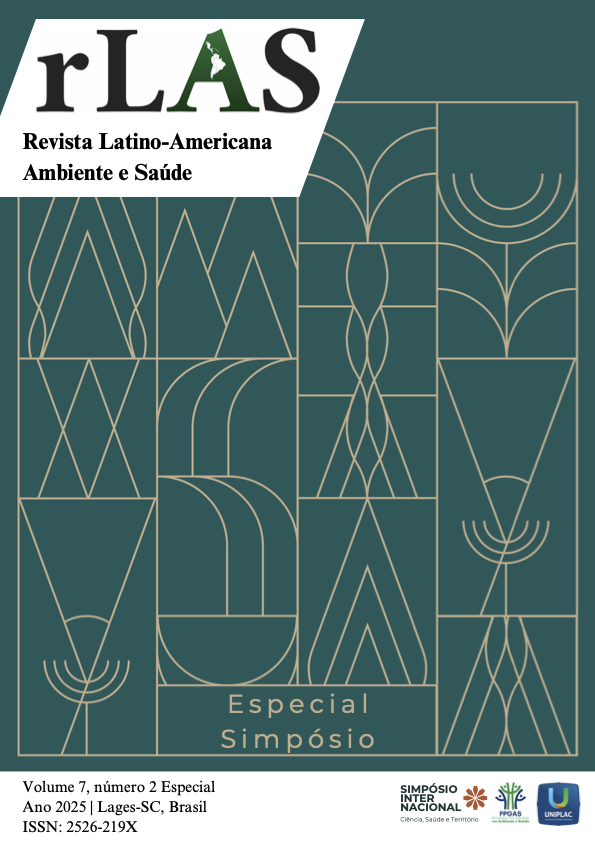Traditional knowledge of medicinal plants used in the city of Lages-SC
Keywords:
ethnobotany, medicinal, knowledgeAbstract
Ethnobotanical studies to rescue popular knowledge about the use of medicinal plants have been intensely carried out in different Brazilian regions. Its use is not always carried out correctly, and this can lead to the loss of the active principle, followed by the drop in the expected effect of the plant in the body, and even its excess can cause damage to health. In many countries, medicinal plants are used and marketed with little or no inspection regarding the presence of heavy metals. The objective of this article was to carry out an ethnobotanical survey of medicinal plants used by residents in the city of Lages-SC. The in situ identification of some specimens of the plants cited by the interviewees was carried out, and the aerial part of the plants were collected for botanical identification. During the study, 115 people were interviewed, aged between 19 and 78 years, with an average of 49 years. Of the interviewees, 80.86% were women. The Asteraceae family was the most cited. Cymbopogon citratus, Achyrocline satureioides and Mentha sp were the plants that obtained the highest relative citation frequency. With the realization of the specimens, it was observed that the residents use the same nomenclature for different plant species.
References
ALBUQUERQUE, U. P.; ANDRADE, L. H. C.; CABALLERO, J. Structure and floristics of homegardens in Northeastern Brazil. Journal of Arid Environments, v. 62, n. 3, p. 491–506, 2005. DOI: https://doi.org/10.1016/j.jaridenv.2005.01.003.
ANDRADE, N. D.; ALMEIDA, B. M.; SOUSA, R. M. S.; ARAÚJO, M.S. Uso das plantas medicinais para fins terapêuticos por estudantes do Ensino Médio. Research, Society and Development, v. 10, n. 4, e59510414484, 2021. DOI: https://doi.org/10.33448/rsd-v10i4.14484.
BLANCKAERT, I.; SWENNEN, R. L.; PAREDES FLORES, M.; ROSAS LÓPEZ, R.; LIRA SAADE, R. Floristic composition, plant uses and management practices in homegardens of San Rafael Coxcatlán, Valley of Tehuacán-Cuicatlán, Mexico. Journal of Arid Environments, v. 57, n. 2, p. 179–202, 2004. DOI: https://doi.org/10.1016/S0140-1963(03)00100-9.
CAJAIBA, R. L.; GOMES, A. F.; SANTOS, M. do C.; MEDEIROS, R. R. de; SILVA, W. B. da. Perfil dos comerciantes de plantas medicinais no município de Uruará, Pará, Brasil. Enciclopédia Biosfera, v. 13, n. 24, p. 1473–1482, 2016. DOI: https://doi.org/10.18677/encibio_2016b_136.
CARNIELLO, M. A.; SILVA, R.S.; CRUZ, M. A. P. B.; GUARIM NETO, G. Quintais urbanos de Mirassol D’Oeste-MT, Brasil: uma abordagem etnobotânica. Acta Amazonica, v. 40, n. 3, p. 451–470, 2010. DOI: https://doi.org/10.1590/s0044-59672010000300005.
FREITAS, A.; COELHO, M.; MAIA, S.; AZEVEDO, R. Plantas medicinais: um estudo etnobotânico nos quintais do Sítio Cruz, São Miguel, Rio Grande do Norte, Brasil. Revista Brasileira de Biociências, v. 10, n. 1, p. 48–59, 2011.
GIRALDO, D.; BAQUERO, E.; BERMUDEZ, A.; OLIVEIRA-MIRANDA, M. Caracterización del comercio de plantas medicinales en los mercados populares de Caracas, Venezuela. Acta Botanica Venezuelica, v. 32, n. 2, p. 267–301, 2009.
HATTORI, E. K. O.; NAKAJIMA, J. N. A família Asteraceae na Estação de Pesquisa e Desenvolvimento Ambiental Galheiro, Perdizes, Minas Gerais, Brasil. Rodriguésia, v. 59, n. 4, p. 687–749, 2008. DOI: https://doi.org/10.1590/2175-7860200859405.
LUCA, V. D. As plantas medicinais do entorno do Parque. In: SANTOS, R. et al. (Org.). Biodiversidade em Santa Catarina: Parque Estadual da Serra Furada. Criciúma: Ediunesc, 2016. p. 147–161.
MACÍA, M. J.; GARCÍA, E.; VIDAURRE, P. J. An ethnobotanical survey of medicinal plants commercialized in the markets of La Paz and El Alto, Bolivia. Journal of Ethnopharmacology, v. 97, n. 2, p. 337–350, 2005. DOI: https://doi.org/10.1016/j.jep.2004.11.022.
MADALENO, I. M. Climate change in the Pacific – Tuvalu case study. In: ILLACAMPA, Y.; BREBBIA, C. A. (Eds.). Ecosystems and Sustainable Development. Southampton: WitPress, 2011.
MERHY, T. S. M.; SANTOS, M. G. A etnobotânica motivando o ensino de Ciências no Ensino Fundamental. Revista Práxis, v. 9, n. 17, p. 9–22, 2017. Disponível em: http://revistas.unifoa.edu.br/index.php/praxis/article/view/676
MONTEIRO, J. M.; ARAÚJO, E. L.; AMORIM, E. L. C.; ALBUQUERQUE, U. P. Local markets and medicinal plant commerce: a review with emphasis on Brazil. Economic Botany, 2010. DOI: https://doi.org/10.1007/s12231-010-9132-1.
PRADO, A. C. C.; RANGEL, E. B.; SOUSA, H. C. de; MESSIAS, M. C. T. B. Etnobotânica como subsídio à gestão socioambiental de uma unidade de conservação de uso sustentável. Rodriguésia, v. 70, 2019. DOI: https://doi.org/10.1590/2175-7860201970019.
RODRIGUES, T. A.; LEANDRO NETO, J.; CARVALHO, T. A. R.; BARBOSA, M. E.; GUEDES, J. C.; CARVALHO, A. V. A valorização das plantas medicinais como alternativa à saúde: um estudo etnobotânico. Revista Ibero-Americana de Ciências Ambientais, v. 11, n. 1, p. 411–428, 2020. DOI: https://doi.org/10.6008/cbpc2179-6858.2020.001.0037.
SILVA, W. B.; CAJAIBA, R. L.; PARRY, M. M. Levantamento etnobotânico de plantas medicinais utilizadas pelos moradores do município de Uruará, estado do Pará, Brasil. Revista Cubana de Plantas Medicinales, v. 29, n. 1, p. 115–131, 2018. DOI: https://doi.org/10.5007/2175-7925.2016v29n1p115.
VÁSQUEZ, S. P. F.; MENDONÇA, M. S.; NODA, S. N. Etnobotânica de plantas medicinais em comunidades ribeirinhas do município de Manacapuru, Amazonas, Brasil. Acta Amazonica, v. 44, n. 4, p. 457–472, 2014. DOI: https://doi.org/10.1590/1809-4392201400423.


